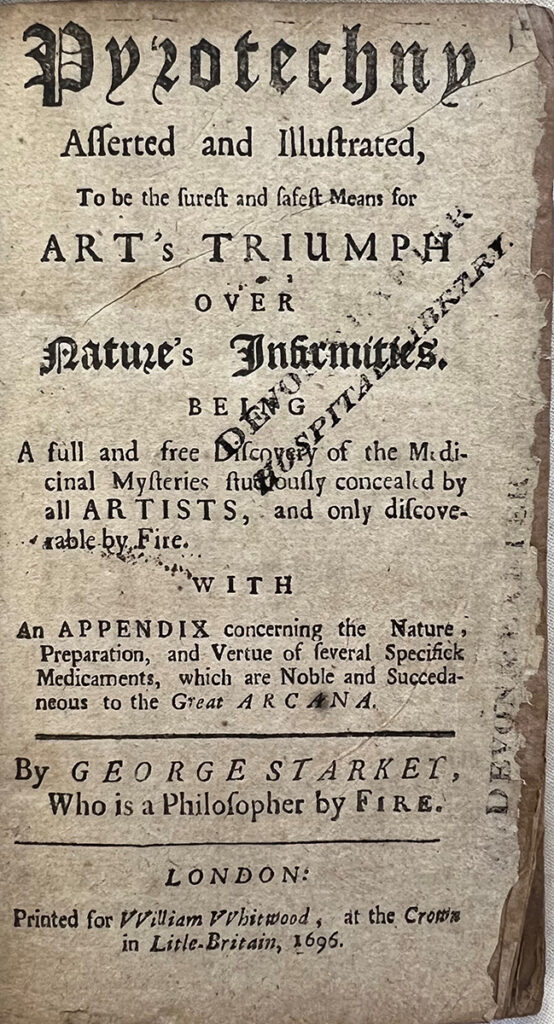Searching for Nature’s Secrets: George Starkey’s Pyrotechny Asserted and Illustrated (1696)
By Clémence Smith
 Would you take on a life-long research project if you believed you could discover nature’s most elusive secrets? The alchemist George Starkey (1627-1665) thought that natural elements (such as plants or minerals) could be purified to obtain certain medicines – and the key to eternal life. His book Pyrotechny Asserted and Illustrated (1696) acts as a guide for the beginner alchemist: in it, he argues that fire is the most effective way to perfect the natural world. Don’t be fooled, though: this text is not a straightforward how-to book. Alchemical knowledge was eagerly guarded and only the most dedicated alchemists could hope for success.
Would you take on a life-long research project if you believed you could discover nature’s most elusive secrets? The alchemist George Starkey (1627-1665) thought that natural elements (such as plants or minerals) could be purified to obtain certain medicines – and the key to eternal life. His book Pyrotechny Asserted and Illustrated (1696) acts as a guide for the beginner alchemist: in it, he argues that fire is the most effective way to perfect the natural world. Don’t be fooled, though: this text is not a straightforward how-to book. Alchemical knowledge was eagerly guarded and only the most dedicated alchemists could hope for success.
Starkey’s text probably won’t catch your attention at first – the book’s plain leather binding and lack of illustrations hardly suggest that it contains a treasure trove of information. However, the opening letter to the reader, written by an anonymous ‘friend of the Author’s’, anticipates the reader’s reaction while also joking (rather clumsily) about the book’s topic: ‘perhaps I and this Book grow too hot for thee to hold any longer, and away thou throwst it’. The narrator highlights his position of power by breaking the fourth wall: he reaches beyond the parameters of the physical book to address the reader directly. Starkey and his friend know and see everything, even what lies beyond the text itself.
Nonetheless, the relationship between writer and reader is far from simple. In the book’s dedicatory letter, Starkey mentions the importance of making alchemical discussions taking place outside England accessible to the English reading public:
‘the Exotickness of the Language in which they wrote keeping them lockt from most of our English Nation, yet whose Lives are neerly concerned in what they Treat of, for this Cause I put Pen to paper’.
Here, Starkey is both interpreter and teacher: by emphasising the ‘Exotickness of the Language’, he shows off his skills and demonstrates his benevolence. Only a couple of pages later, though, Starkey worries about what might happen if alchemical knowledge falls into the wrong hands:
‘Nor do we as in other Arts, write with intent that our writings may be understood promiscuously by every Reader, and this is peculiar to this Art, and commanded in the Gospel, that Pearls be not cast before Swine, and for this end we so write as not to be understood’.
This phrase is important because it acknowledges that trading alchemical knowledge can lead to significant wealth: crucially, monetising secrets depends on their exclusivity. Starkey deliberately conceals his alchemical knowledge by using complicated syntax and figurative language. He only offers us glimpses of nature’s secrets before squirrelling them away: this performance inevitably makes the reader even more eager to find out the truth for themselves.
But not so fast! You must first prove to be worthy of alchemical knowledge before acquiring it. Starkey outlines that successful alchemists are devout Christians, cannot be greedy or egotistical, and must be enthusiastic and morally sound. Furthermore, bumps in the road should not discourage you, as Starkey explains that ‘by asking, seeking, and knocking, he shall find, receive and have opened to him, the Secrets and Mysteries of Nature’. It is interesting to note Starkey’s use of biblical language here: practicing alchemy was primarily an act of religious devotion, as unveiling ‘Nature’ could lead to a deeper understanding of God. This passage goes on to describe alchemy as a strikingly lonely process: you will need to lead a long and pious life filled with relentless work to stand a chance of uncovering these ‘Secrets and Mysteries’.
The learning curve is steep: the cryptic symbols that Starkey uses make what we don’t know immediately apparent on the page. And yet this is not necessarily a bad thing, as budding alchemists can test their skills by attempting to decode them. The historian Pamela H. Smith argues that in the sixteenth and seventeenth centuries, alchemy bridged the gap between manual labour and textual studies, as practitioners were encouraged to read each other’s work in addition to conducting laboratory experiments. Starkey’s book is no bigger than the palm of your hand; the front page’s tattered edges imply that the book was leafed through by many. It is easy to imagine that someone might have kept it in their pocket to quickly reference the book’s appendix while being hard at work in the laboratory.
Pyrotechny Asserted and Illustrated is a fascinating little book that opens a window onto a world in which alchemical knowledge was closely guarded. The most lucrative sources of information were often unassuming in appearance. To decode these secrets, the alchemist must learn to look beyond the immediately apparent. This required not only a certain type of method, but also a special kind of person: one who recognised the potential dangers of playing with fire.
